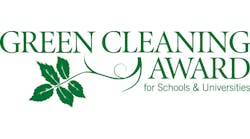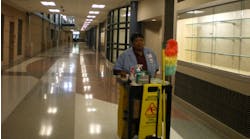GCA College/University Best New Program
Spelman College, Atlanta
PROGRAM INFORMATION
Number of students: 2,204
Square footage maintained: 1,258,971
Number of full-time custodians: 47
Annual cleaning budget: 249,000
Green cleaning team members: Art Frazier, Director; Flora Thomas, Jackie Spann, Angel Dodson, Sarah Bailey, Head Custodians; Don Blackston, Associate Director of Facilities Management & Services; Aramark, Cleaning Contractor; ECOLAB, Janitorial Product Distributor; AUC Bonner Community Services, Community Group
Spelman has adopted the appropriate structure and resources to support sustainability initiatives:
-Vision. Spelman created a green campus that is energized, well-equipped and supported across campus. The college optimizes all spaces, incorporates modern conveniences and promotes sustainability. Designing and implementing a welcoming, safe, supportive and sustainable campus and its infrastructure are foundational to Spelman’s ability to deliver signature experiences for the Atlanta University Center.
-Purchasing: Further planning for fund raising to acquire more land in the surrounding area, and collaboration with other AUC institutions and the external community in the planning/development of properties in the vicinity.
-Goal. To expand and improve the physical campus, technology infrastructure and residential programs in order to facilitate a seamless living and learning environment with an increased focus on environmental responsibility, and increased student achievement and overall satisfaction with the collegiate experience.
-Society. Educate students, staff, faculty, alumnae and the community regarding their responsibilities as local, regional and global citizens of the environment.
-Scholarship. Encourage collaborative and individual scholarship and curriculum in sustainability; develop academic, corporate and community partners in promoting sustainability activities for students, faculty and staff.
-Infrastructure. Develop strategies to improve waste, water and energy management; alternative transportation to decrease by 10 percent the number of single-occupancy vehicles commuting to campus and increase alternative transportation and campus support for commuters.
-Strategies. Strategies designed to improve waste, water, energy management in daily operations.
As part of its environmental stewardship commitment, Spelman develops not only unique solutions for our faculty, staff, and students, but also is committed to elevating environmental commitments to the AUC. Maintaining a healthy and safe indoor environment is foundational in its commitment to providing unparalleled service in all the venues. Spelman’s cleaning operations and the products used on a daily basis ensure that it provides socially responsible services and an economic impact to the Spelman family. It is committed to purchasing resources responsibly and efficiently by weaving daily green cleaning into our daily operations.
Providing daily green cleaning products helps ensure human health and provides a cleaning service that minimizes its environmental footprint. The Spelman green cleaning program provides a more healthful indoor environment for educators, workers, students and staff. The green cleaning program also reinforces mindsets and habits that lead to more responsible personal habits. The environmental commitment uses safer chemicals to protect users while minimizing environmental damage, reduces packaging and transportation impact through the use of concentrated products. The green cleaning program reduces water use and pollution potential and aligns with LEED certification criteria. The economic picture reduces the quantity of cleaning products necessary for daily cleaning; transitioning from ready-to-use (RTU) to concentrate products saves money and reduces turnover rate through demonstration of worker safety priority.
Spelman uses ec-H20 technology, which electrically converts water into a superior cleaning solution that cleans better; increases cost savings and productivity gains up to 35% by eliminating training, purchasing, storing, handling, and chemical mixing tasks and costs; improves safety by improving floor traction to reduce slip and fall incidents; and reduces environmental impact compared with traditional cleaning chemicals and methods.
Green cleaning is a key factor in making a building green. A proper green cleaning program can positively affect the indoor environment and materials purchasing practices, as well as contribute to reduced energy and water usage. The key components are green buildings, resource management, transportation, procurement and sustainable agriculture.
The intent is to reduce the environmental impacts of cleaning products, disposable paper products and trash bags.
Spelman also has implemented sustainable purchasing for cleaning products.
All employees receive new-hire orientation that covers all of the OSHA requirements, Spelman culture, business conduct policy. Refresher training is given semi-annually or as needed. Green building cleaning and operating standards (understanding LEED-EB O&M) are implemented with each new-hire. All employees are briefed on what the APPA staffing guide defines for APPA levels 1 through 5.
Spelman delivers the brand and innovations such as blue cleaning, wireless handheld, outdoor waste and water management. Spelman utilizes AIM (computerized work-order system) for its daily operations. Inspections are performed weekly, monthly and quarterly. The templates are based on attaining a minimum of APPA level 3.
LEED-EB O&M reference guide-criteria under the green cleaning section of the IEQ section EPA standards for Indoor Air Quality are discussed during monthly meetings to ensure the standards are met by the housekeeping staff. Weekly coordination meetings, quarterly management joint reviews and annual program review are maintained. Training documentation and customer satisfaction surveys are audited annually.
The overall Quality Assurance and Quality Control process will encompass the generation of measurement data through qualified supervisory personnel provided with required competency based training, technology, and procedures. This enables the management team to effectively maintain accountability to quality standards, scope of work requirements and performance measurement targets.
President Dr. Beverly Daniel Tatum has been a strong advocate for change and innovation at Spelman. Her vision for the future of the institution along with her understanding of the environmental challenges facing the society and the planet today have proven catalysts in promoting sustainability on campus. The campus sustainability initiatives are implemented and evaluated continually by the Facilities Management and Services office, under the leadership of Arthur E. Frazier III, Director of Facilities Management and Services. These initiatives--as the result of the collaborative efforts and ongoing brainstorming sessions with the administration and the decisionmaking authorities of the institution--chart the path that guides Spelman toward a sustainable and energy-efficient future. With the dedication and perseverance of Frazier, the office of Facilities Management and Services now functions as the primary office for campuswide sustainable issues. His team continually seeks opportunities to integrate sustainability into infrastructural improvements and other operational practices. Thus, the sustainability efforts at the Spelman College could be attributed to the excellent leadership of the president’s office and the expertise of the senior management. A recent signatory of the American College and University Presidents' Climate Commitment (ACUPCC), Spelman College is an example of how the prudence of the president in tandem with the determination of the staff members could advance an institution towards its ultimate mission of climate neutrality.
In December 2011, the facilities management and services decided to take the initiative of going beyond green to blue cleaning. Blue cleaning eliminates chemicals and substitutes them for electrically activated water to create a more environmentally responsible approach to cleaning. This will help to reduce environment impact and improve indoor air quality. Going beyond green to blue will greatly reduce or eliminate the need for buying, transporting, storing, handling and disposing of traditional cleaning chemicals and packaging--and save time and money on training and regulatory compliance.
In 2008, Spelman College hosted the Collegiate Environmental Sustainability Conference to encourage colleges and universities to implement environmental projects on their campuses. Spelman was the United Negro College Fund’s first Building Green Learning Institution, and was the first HBCU to become a member of the U.S. Green Building Council and the Association for the Advancement of Sustainability in Higher Education.



